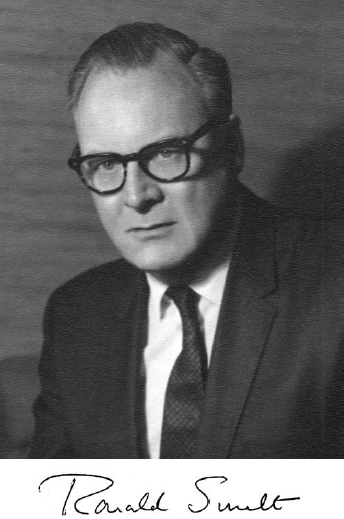1913–2005
Elected in 1971
“For development of ingenious mathematical solutions to
practical problems of aircraft and space vehicle design and testing.”
BY ALAN BROWN
RONALD SMELT, or Roy as he was generally known, retired corporate vice president and chief scientist of the Lockheed Corporation, died on February 17, 2005, at the age of 91.
Roy was one of four children of Henry and Florence Smelt, born in the coal mining village of Houghton Le Spring in County Durham, England, on December 4, 1913. He was educated at King’s College, Cambridge University, and earned B.A. and M.A. degrees in mathematics in 1935 and 1939, the latter while working at the Royal Aircraft Establishment in Farnborough, England. He completed his education in 1961, earning a doctorate in aeronautical engineering from Stanford University for his dissertation on determination of the drag characteristics of orbiting vehicles.
His career at the Royal Aircraft Establishment from 1935 to 1948 spanned the initial development of the jet engine and World War II and its aftermath. He worked with Sir Frank Whittle on the first flight of Sir Frank’s jet engine while he was chief of high-speed flight from 1940 to 1945. Roy determined the characteristics of the German V-1 missile and how to combat it and was a member of the team that came to the United States to procure aircraft for Britain prior to the U.S. entry into World War II. From 1945 to 1948 he was head of the guided-weapons department, prior to his emigration to the United States in what is colloquially known as the postwar “brain drain.”
Roy’s first employer in the United States was the U.S. Navy Ordnance Laboratory, where he became deputy chief for aeroballistics research before leaving to become chief of the gas dynamics facility at the Arnold Research Organization (ARO), Tullahoma, Tennessee, where he worked from 1950 to 1957. In 1958 he joined the recently formed Lockheed Missiles and Space Company (LMSC) and stayed with Lockheed until his retirement in 1978.
His interest in wind tunnels at ARO sparked the development of high-temperature facilities at the LMSC research laboratories in Palo Alto, California, where he became director of research and was instrumental in turning that facility into one of the best of its kind in the aerospace industry. He moved on to become manager of the Discoverer space satellite system from 1959 to 1960, chief scientist from 1960 to 1962, and vice president and general manager of the space program division from 1962 to 1963.
From 1963 to 1978, Roy was chief scientist and a corporate vice president of the then-parent Lockheed Aircraft Corporation in Burbank, California. He was responsible for all corporate independent research and development, he established the Lockheed Research Council, and he arranged ties with other notable research facilities in the country, such as General Motors, Bell Laboratories, DuPont, and some U.S. Department of Defense establishments.
Roy was elected to the National Academy of Engineering in 1971 “for development of ingenious mathematical solutions to practical problems of aircraft and space vehicle design and testing.” He participated in a number of activities for the National Aeronautics and Space Administration (NASA) and the American Institute of Aeronautics and Astronautics (AIAA). He was a member of the NASA Committee on Space Vehicle Aerodynamics from 1955 to 1966 and chairman of the Research Advisory Committee on Space Vehicles from 1966 to 1973. He was chairman of the Research and Technology Advisory Council from 1973 to 1977. Concurrently, from 1970 to 1974 he chaired the Technical Advisory Board to the U.S. Department of Transportation. He was also an honorary fellow
of the AIAA, honorary director-at-large from 1966 to 1968, and a vice president in 1968, and he served two terms as president from 1969 to 1970. In 1978 he was the Guggenheim lecturer for the International Congress of Aerospace Sciences.
Dr. Smelt served on advisory committees for Stanford University from 1988 to 1989 and was on the advisory committee for the NASA–Stanford Center for Turbulence Research. He was also a member of the American Physical Society, a fellow of the American Astronautical Society, a fellow of the Cambridge Philosophical Society, and a fellow of the Royal Aeronautical Society. From the latter he received the Simms Gold Medal in 1962 for his paper on the Lockheed Agena satellite. He also gave an invited paper, “Looking Ahead in Aeronautics and Astronautics—A U.S. View,” as part of the Royal Aeronautical Society Second Century Papers, in 1969.
Ronald Smelt married Marie Annita Collings on November 2, 1940. They had one son, David. Sadly, they both predeceased Ronald—Marie in May 1964 and David in October 2004. In January 1965, Dr. Smelt married Jean Lorraine Stuart, who, together with her daughter Anne and Roy’s daughter-in-law Cheryl Smelt, survive him.





